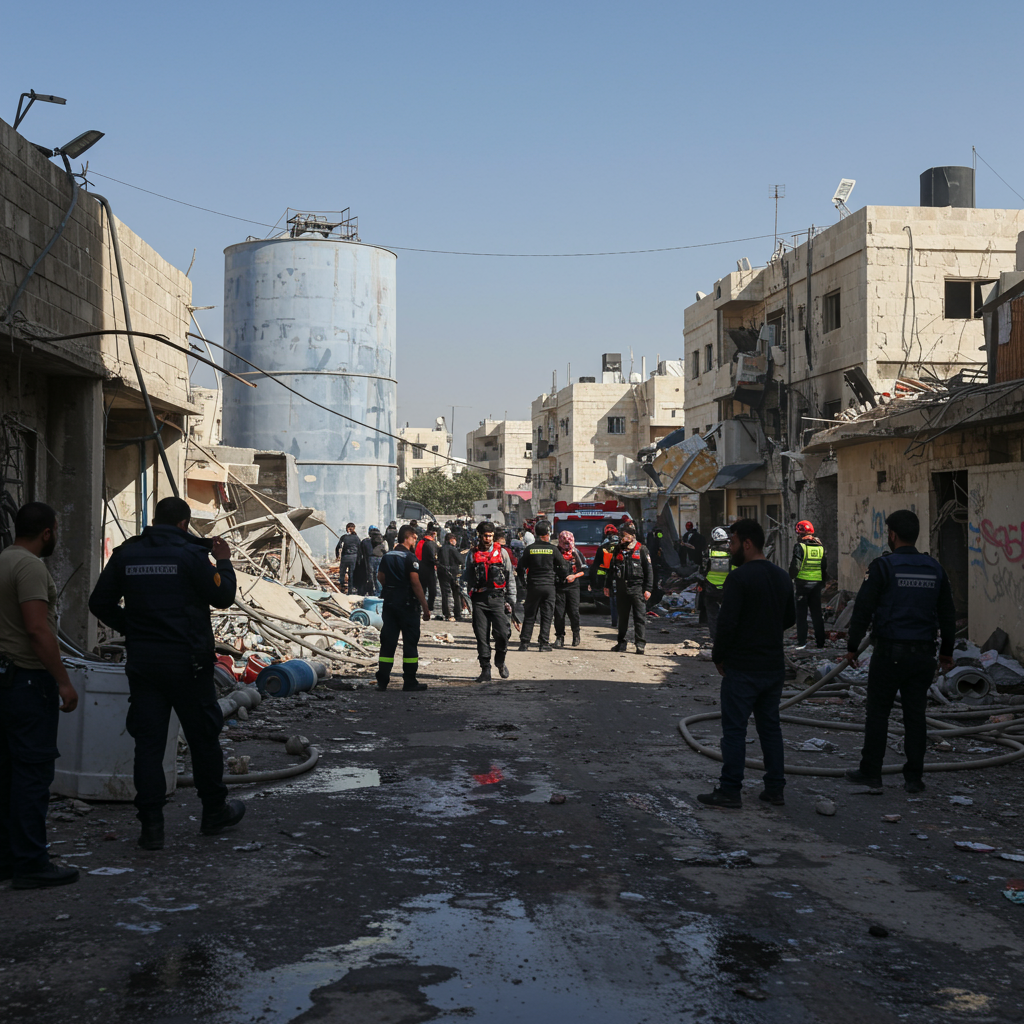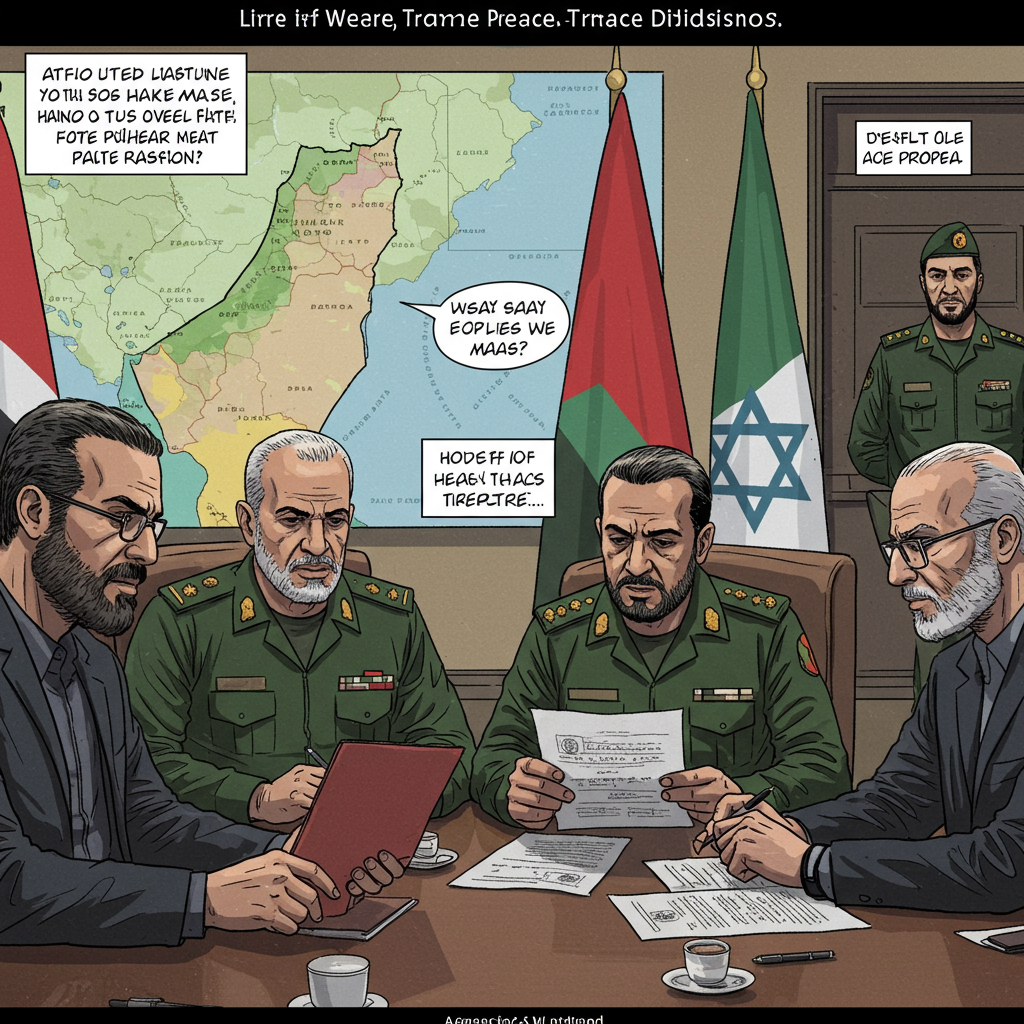A tragic air strike in central Gaza’s Nuseirat refugee camp has reportedly killed ten people, including six children. Emergency services in Gaza stated the strike occurred Sunday as people waited to fill water containers. This deadly incident prompted the Israeli military to acknowledge a “technical error.”
Bodies of those killed were taken to Nuseirat’s al-Awda Hospital. A doctor there confirmed the hospital received the fatalities and treated 16 injured individuals, including seven children. Eyewitnesses described a drone firing a missile. The strike hit a crowd queuing with empty jerry cans near a water tanker.
IDF Claims “Technical Error” Caused Civilian Deaths
The Israeli military, known as the IDF, acknowledged the strike. They stated a “technical error” happened with a munition. The military said the intended target was an Islamic Jihad “terrorist.” However, the munition reportedly fell “dozens of metres” away from the target.
The IDF confirmed the incident is under review. They added they are aware of the “claim regarding casualties in the area.” The military stressed its efforts to mitigate harm to civilians “as much as possible.” It expressed regret for “any harm to uninvolved civilians.” Different accounts exist regarding the specific target and why the strike missed. The military’s admission of an error is a key point in their response.
Location of Nuseirat Strike Verified
Video footage captured the aftermath of the strike. It shows many people rushing to help injured individuals. Children are visible lying among yellow jerry cans. BBC Verify examined this video evidence. They were able to pinpoint the location.
The site is on a road about 80 metres (262ft) south-west of the Nuseirat Junior High School. It sits two buildings away from a structure listed as a kindergarten. Satellite imagery from three weeks prior showed a tanker truck across the street. However, the video could not determine exactly what struck the site. It also couldn’t show the munition’s direction if it was a malfunctioning Israeli weapon. The verification process confirms the site and tragic scene but leaves some technical questions unanswered.
Escalation of Attacks Across Gaza
The Nuseirat strike happened amid escalated Israeli aerial attacks across the Gaza Strip. Gaza’s Civil Defence Agency reported other significant casualties on the same Sunday. A spokesperson stated 19 other Palestinians died that day. These deaths occurred in three separate strikes. They targeted residential buildings in central Gaza and Gaza City.
The total reported death toll across Gaza from Israeli strikes on Sunday reached at least 32, according to local health officials. This pattern of multiple strikes resulting in civilian deaths highlights the intense nature of ongoing military operations across the territory. The high daily death counts paint a grim picture of the situation on the ground.
Humanitarian Crisis Deepens
Beyond direct strikes, the humanitarian situation in Gaza remains dire. Most of Gaza’s population has been displaced multiple times since the conflict began. Estimates suggest over 90% of homes are damaged or destroyed. Essential systems have collapsed. This includes healthcare, water, sanitation, and hygiene networks. Severe shortages persist for food, fuel, medicine, and shelter.
This crisis is reflected in healthcare facilities. The International Committee of the Red Cross (ICRC) runs a field hospital in Rafah, southern Gaza. They reported treating significantly more mass casualty cases recently. In the last six weeks, they treated more such cases than in the previous 12 months combined. This surge underscores the “horrific conditions civilians in Gaza are enduring,” the ICRC stated.
Aid Distribution Sites Become Hotspots for Violence
Accessing essential aid has become increasingly dangerous. The ICRC hospital in Rafah provides stark data. On a single Saturday, it received 132 patients with “weapon-related injuries.” Thirty-one of these patients died. The “overwhelming majority” had gunshot wounds. Responsive individuals reported they were trying to reach food distribution sites when injured.
Since new food distribution sites opened on May 27, the Rafah hospital treated over 3,400 weapon-wounded patients. It recorded over 250 deaths from mass casualty incidents. This number exceeds the total mass casualty cases treated at the hospital in the entire year prior.
Another incident occurred Saturday near an aid site in southern Gaza. Nasser hospital reported 24 people killed. Witnesses claimed Israeli troops opened fire as people tried to access food. The Israeli military offered a different account. They stated there were “no known injured individuals” from IDF fire near that site. A military official added that warning shots were fired to disperse people perceived as a threat. Conflicting reports about these events near aid sites are common.
Disputes Over Aid-Related Killing Figures
The UN human rights office tracks aid-related killings. As of a recent report, they recorded 789 such deaths. Of these, 615 occurred near sites run by the Gaza Humanitarian Foundation (GHF). This foundation is backed by the US and Israel. Its sites opened on May 27 and use US private security contractors within military zones. The remaining 183 killings were near UN and other aid convoys.
The IDF acknowledged incidents of civilian harm near aid sites. It stated it works to minimize “possible friction” between the population and forces. However, the GHF disputes the UN’s figures. The GHF accused the UN of using “false and misleading” statistics. These statistics reportedly came from Gaza’s Hamas-run health ministry. A GHF boss stated he doesn’t deny deaths near sites. But he challenged the claim that “100% of those casualties are being attributed to close proximity to GHF.” The GHF operates four distribution centres with private security. There is controversy around its operations. Reports suggest the most deadly attacks on aid sites have been linked to UN convoys, according to a GHF spokesperson.
Critical Fuel Shortage Severely Impacts Services
A particularly critical aspect of the crisis is the fuel shortage. This week, 75,000 litres of fuel entered Gaza. This was the first shipment in 130 days. However, the United Nations stated this amount is “far from enough.” It cannot meet the daily needs of the population. It also cannot support vital civilian aid operations.
Nine UN agencies warned on Saturday that Gaza’s fuel shortage is “critical.” If fuel runs out, it impacts essential services. These include hospitals, water systems, sanitation networks, and bakeries. Reports indicate hospitals are already “going dark.” Maternity, neonatal, and intensive care units are failing. Ambulances can no longer move. The lack of fuel cripples the remaining fragile infrastructure.
Broader Conflict Context
The current conflict began following Hamas’s cross-border attack on Israel. This attack occurred on October 7, 2023. About 1,200 people were killed in that attack. 251 others were taken hostage. Israel launched its military campaign in Gaza in response.
Since October 7, at least 57,882 people have been killed in Gaza. This figure comes from the Hamas-run health ministry. This ministry’s count does not distinguish between combatants and civilians. Other reports cite over 58,000 deaths, with over half identified as women and children. The immense scale of reported casualties underscores the conflict’s devastating impact.
Stalled Ceasefire Negotiations
Efforts to secure a ceasefire remain difficult. Indirect talks between Israel and Hamas appear to be faltering. Reports last week indicated negotiations were near collapse. Key issues remain unresolved. These disagreements centre on the conflict’s ultimate outcome and withdrawal terms.
Hamas has proposed releasing remaining hostages. They are believed to hold around 50, including about 20 thought to be alive. In exchange, Hamas demands a full withdrawal of Israeli troops. They also seek a complete end to the war. Israel has stated its condition for ending the conflict. They require Hamas to surrender, disarm, and its leadership to go into exile. These fundamental differences create a significant hurdle. A US-backed plan proposed a 60-day truce. It envisioned phased hostage releases. However, reaching a deal remains elusive due to these deep divisions. Even efforts involving figures like US President Donald Trump have faced new sticking points. These reportedly include issues like Israeli troop deployment during a potential truce.
Frequently Asked Questions
What happened during the recent strike in Gaza that killed children?
A strike occurred Sunday in central Gaza’s Nuseirat refugee camp. Gaza officials reported it killed ten people, including six children. They were reportedly waiting to collect water. Eyewitnesses said a drone fired a missile at a crowd. The Israeli military admitted the strike happened. They claimed a “technical error” caused the munition to fall off target while aiming for a militant.
How is the humanitarian crisis impacting civilians beyond direct strikes?
The crisis is severe. Most of Gaza’s population is displaced. Homes are widely destroyed. Essential services like healthcare and water have collapsed. There are critical shortages of food, fuel, medicine, and shelter. Hospitals face fuel shortages, impacting their ability to function. Aid distribution sites have become dangerous areas, with many reported killings and injuries occurring near them.
What are the conflicting reports surrounding aid distribution deaths?
Reports from the ICRC and UN human rights office detail numerous deaths and injuries near aid sites. Witnesses claim Israeli troops fired at people accessing aid. The IDF denies firing at crowds. They state troops fire warning shots or only at perceived threats. The GHF, which operates some aid sites, disputes the UN’s figures on aid-related killings, accusing the UN of using misleading statistics from the Hamas-run health ministry and challenging the attribution of deaths solely to their sites.
Conclusion
The strike in Nuseirat, resulting in reported child casualties and an Israeli military admission of error, underscores the severe risks civilians face daily in Gaza. This incident occurred amidst escalating attacks and a deepening humanitarian crisis. The situation is compounded by critical shortages of essential resources like fuel and ongoing disputes over aid delivery safety. As ceasefire talks stall, the human cost of the conflict continues to rise. The events highlight the devastating impact on ordinary civilians struggling to survive.




